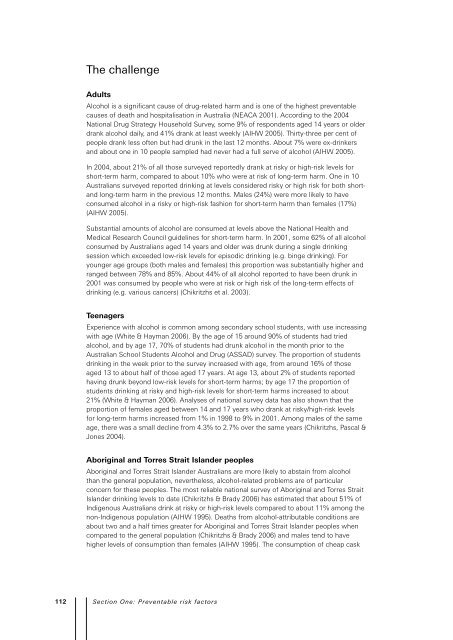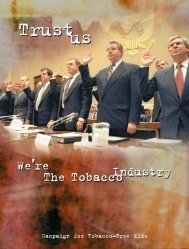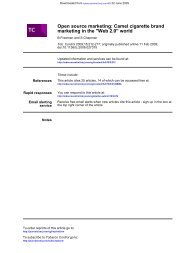National Cancer Prevention Policy - Tobacco Control Supersite
National Cancer Prevention Policy - Tobacco Control Supersite
National Cancer Prevention Policy - Tobacco Control Supersite
You also want an ePaper? Increase the reach of your titles
YUMPU automatically turns print PDFs into web optimized ePapers that Google loves.
The challenge<br />
Adults<br />
Alcohol is a significant cause of drug-related harm and is one of the highest preventable<br />
causes of death and hospitalisation in Australia (NEACA 2001). According to the 2004<br />
<strong>National</strong> Drug Strategy Household Survey, some 9% of respondents aged 14 years or older<br />
drank alcohol daily, and 41% drank at least weekly (AIHW 2005). Thirty-three per cent of<br />
people drank less often but had drunk in the last 12 months. About 7% were ex-drinkers<br />
and about one in 10 people sampled had never had a full serve of alcohol (AIHW 2005).<br />
In 2004, about 21% of all those surveyed reportedly drank at risky or high-risk levels for<br />
short-term harm, compared to about 10% who were at risk of long-term harm. One in 10<br />
Australians surveyed reported drinking at levels considered risky or high risk for both short-<br />
and long-term harm in the previous 12 months. Males (24%) were more likely to have<br />
consumed alcohol in a risky or high-risk fashion for short-term harm than females (17%)<br />
(AIHW 2005).<br />
Substantial amounts of alcohol are consumed at levels above the <strong>National</strong> Health and<br />
Medical Research Council guidelines for short-term harm. In 2001, some 62% of all alcohol<br />
consumed by Australians aged 14 years and older was drunk during a single drinking<br />
session which exceeded low-risk levels for episodic drinking (e.g. binge drinking). For<br />
younger age groups (both males and females) this proportion was substantially higher and<br />
ranged between 78% and 85%. About 44% of all alcohol reported to have been drunk in<br />
2001 was consumed by people who were at risk or high risk of the long-term effects of<br />
drinking (e.g. various cancers) (Chikritzhs et al. 2003).<br />
Teenagers<br />
Experience with alcohol is common among secondary school students, with use increasing<br />
with age (White & Hayman 2006). By the age of 15 around 90% of students had tried<br />
alcohol, and by age 17, 70% of students had drunk alcohol in the month prior to the<br />
Australian School Students Alcohol and Drug (ASSAD) survey. The proportion of students<br />
drinking in the week prior to the survey increased with age, from around 16% of those<br />
aged 13 to about half of those aged 17 years. At age 13, about 2% of students reported<br />
having drunk beyond low-risk levels for short-term harms; by age 17 the proportion of<br />
students drinking at risky and high-risk levels for short-term harms increased to about<br />
21% (White & Hayman 2006). Analyses of national survey data has also shown that the<br />
proportion of females aged between 14 and 17 years who drank at risky/high-risk levels<br />
for long-term harms increased from 1% in 1998 to 9% in 2001. Among males of the same<br />
age, there was a small decline from 4.3% to 2.7% over the same years (Chikritzhs, Pascal &<br />
Jones 2004).<br />
Aboriginal and Torres Strait Islander peoples<br />
Aboriginal and Torres Strait Islander Australians are more likely to abstain from alcohol<br />
than the general population, nevertheless, alcohol-related problems are of particular<br />
concern for these peoples. The most reliable national survey of Aboriginal and Torres Strait<br />
Islander drinking levels to date (Chikritzhs & Brady 2006) has estimated that about 51% of<br />
Indigenous Australians drink at risky or high-risk levels compared to about 11% among the<br />
non-Indigenous population (AIHW 1995). Deaths from alcohol-attributable conditions are<br />
about two and a half times greater for Aboriginal and Torres Strait Islander peoples when<br />
compared to the general population (Chikritzhs & Brady 2006) and males tend to have<br />
higher levels of consumption than females (AIHW 1995). The consumption of cheap cask<br />
112 Section One: Preventable risk factors




